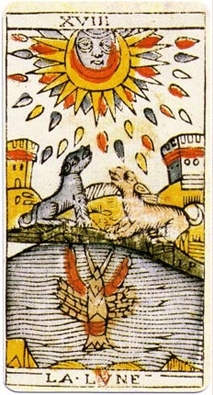The Moon (XVIII) is the eighteenth trump or Major Arcana card in most traditional tarot decks. It is used in game playing as well as in divination.


Description
editThe card depicts a night scene, where two large pillars are shown. A wolf and a domesticated dog howl at the Moon while a crayfish emerges from the water. The Moon has "sixteen chief and sixteen secondary rays" and "[is] shedding the moisture of fertilizing dew in great drops" (totaling 15 in the Rider–Waite deck) which are all Yodh-shaped.[1]
Interpretation
editAccording to A.E. Waite's 1911 book The Pictorial Key to the Tarot, "The card represents life of the imagination apart from life of the spirit... The dog and wolf are the fears of the natural mind in the presence of that place of exit, when there is only reflected light to guide it... The intellectual light is a reflection and beyond it is the unknown mystery which it cannot reveal." Additionally, "It illuminates our animal nature" and according to Waite, "the message is 'Peace, be still; and it may be that there shall come a calm upon the animal nature, while the abyss beneath shall cease from giving up a form.'"[2]
Waite writes that the Moon card carries several divinatory associations:[3]
18.THE MOON--Hidden enemies, danger, calumny, darkness, terror, deception, occult forces, error. Reversed: stability, constancy, silence, lesser degrees of deception and error.
In Astrology, the Moon card is associated with the mutable-water sign of Pisces and its ruling planet, Neptune.[4]
Alternative decks
edit- In the "Flemish Deck" by Vandenborre, the moon shows a woman seated in the right-hand corner with a tree in the left hand corner. The Moon is directly above her. She is shown with a distaff in her right hand and spinning thread with her left hand.
- In the 17th century French Vieville tarot deck, instead of the above scene there is an older woman beside a tree, spinning with a spindle and distaff as the Moon shines above.
References
edit- ^ "The Pictorial Key to the Tarot: Being fragments of a Secret Tradition under the Veil of Divination".
- ^ Waite, Arthur Edward (1911). The Pictorial Key to the Tarot: Being Fragments of a Secret Tradition Under the Veil of Divination. London: W. Rider. OCLC 22367742.
- ^ Waite, Arthur Edward (2005). The Pictorial Key to the Tarot. Mineola, New York: Dover Publications. ISBN 978-0486442556. OCLC 57549699.
- ^ "A Taste of Tarot: Pisces and The Moon". Tarot.com. Retrieved 2023-07-15.
Further reading
edit- Juliette Wood, Folklore 109 (1998):15–24, The Celtic Tarot and the Secret Tradition: A Study in Modern Legend Making (1998)
External links
edit- The History of the Moon Card from The Hermitage.
- The Moon from Joan Bunning's Learning the Tarot: A Tarot Book for Beginners
- The Meaning of The Moon Card in Various Reading Contexts from tarot practitioner Lizzie Burgess